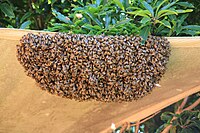
Photo from wikipedia
Abstract Fungicides are commonly applied to prevent diseases in eastern North American cherry orchards at the same time that honey bees (Apis mellifera L. (Hymenoptera: Apidae)) are rented for pollination… Click to show full abstract
Abstract Fungicides are commonly applied to prevent diseases in eastern North American cherry orchards at the same time that honey bees (Apis mellifera L. (Hymenoptera: Apidae)) are rented for pollination services. Fungicide exposure in honey bees can cause negative health effects. To measure fungicide exposure, we sampled commercial honey bee colonies during orchard bloom at two commercial tart cherry orchards and one holding yard in northern Michigan over two seasons. Nurse bees, foragers, larvae, pollen, bee bread, and wax were screened for captan, chlorothalonil, and thiophanate-methyl. We also looked at the composition of pollens collected by foragers during spring bloom. We found differences in fungicide residue levels between nurse bees and foragers, with higher captan levels in nurse bees. We also found that residue levels of chlorothalonil in workers were significantly increased during tart cherry bloom, and that nurse bees from hives adjacent to orchards had significantly higher chlorothalonil residues than nurse bees from hives kept in a holding yard. Our results suggest that fungicide exposure of individual honey bees depends greatly on hive location in relation to mass-flowering crops, and worker role (life stage) at the time of collection. In some pollen samples, captan and chlorothalonil were detected at levels known to cause negative health effects for honey bees. This study increases our understanding of exposure risk for bees under current bloom time orchard management in this region. Further research is needed to balance crop disease management requirements with necessary pollination services and long-term pollinator health.
Journal Title: Journal of Economic Entomology
Year Published: 2023
Link to full text (if available)
Share on Social Media: Sign Up to like & get
recommendations!